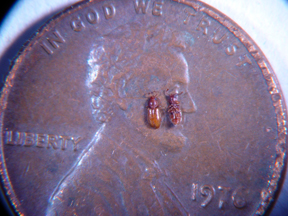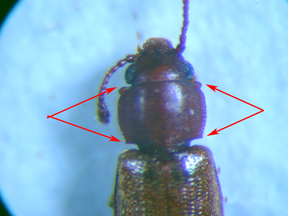Fall invading insects
In fall, boxelder bugs, Asian lady beetles, cluster flies, conifer seed bugs and grain beetles may invade homes seeking warmth. Seal cracks and use insecticides on exterior walls to reduce entry. Vacuum indoor bugs and expect some to linger all winter.
Editor’s note: This article is from the archives of the MSU Crop Advisory Team Alerts. Check the label of any pesticide referenced to ensure your use is included.
Autumn is the time of year when we humbly and gratefully thank our lucky stars for surviving, though possibly not unscathed, the summer onslaught of biting insects, stinging insects and other annoying arthropods. However, we are not out of the woods yet: there could be large numbers of insects out there waiting to invade our homes and businesses. I say “could be” because we won’t know that for sure until we get the first few frosts of the season.
There are four or five species of fall invaders that might show up on the outside walls of our homes looking for a nice crack or crevice to crawl into to protect themselves from our extreme winter weather (a depressing thought all by itself). I don’t think these bugs intentionally seek out our homes for this purpose. It’s just that our homes provide so many places for these bugs to hide in to pass the winter. As nighttime temperatures cool many of us will begin to see these insects congregating on the outside of the south and west facing walls of our homes. The unlucky may see thousands of them. If they just stayed on the outside of our homes, I think most people would not mind them so much, but they don’t stay on the outside. In bad years hundreds may find their way inside to the very space where we spend the winter.
In general, these bugs are harmless: most do not bite; they do not eat fabrics, stored foods, wood or pets; and they do not lay eggs in the house. For most of the people I talk to about these bugs, the fact that they are harmless is of little or no consequence. Most people would rather not share their living space with a bunch of annoying, albeit harmless, bugs.
What to do, what to do?
Many people who offer advice on reducing these unwelcomed guests suggest sealing exterior cracks and holes with caulking to prevent their entry inside. This may work on older homes with clapboard siding, but no amount of caulk is going to keep them out of a home with vinyl siding. Vinyl siding and soffits are not tightly nailed down; these are nailed loosely or as they say in the trade, “hung.” It is done this way to allow these vinyl panels to expand and contract with changing temperatures. Fall invading insects can find their way around the edges of these loose panels and into wall voids and attics. If homes were not heated these bugs would likely be content to go dormant and spend the winter in these cozy confines. Unfortunately, our homes are heated and this warmth keeps these bugs active and as such, they find their way into the living space probably around baseboards, window and door moldings, openings for electrical outlets and fixtures, openings for heating/cooling vents and other such pathways. There is very little that can be done once the bugs are inside the walls. In homes invaded by these bugs, it is very common and likely that one will continue to see them throughout the winter.
Even aggressive and costly insecticide applications may not be effective because it is nearly impossible to treat every hidden area that may be harboring insects. Sealing cracks around electrical outlet boxes, switches and light fixtures, and around window and baseboard molding on the inside walls will help keep the bugs trapped within the walls. In older homes with double-hung windows equipped with pulleys, insects commonly enter living areas through the pulley opening. Masking tape applied over the opening will keep insects from entering through this route. A vacuum cleaner is a pretty effective method of removing the sluggish, slow moving bugs from inside the house. Spraying the outside walls of homes, especially the south and west facing walls with a long lasting insecticide registered for this use in September can help reduce the number of insects entering homes. These sprays should be applied when the first bugs are noticed congregating on outside walls. Before treating the whole house, spray a small test area to make sure the insecticide does not stain the siding or paint. Be sure to read and follow all directions on the pesticide label. Spraying the outsides of homes will, no doubt, involve spraying above one’s head so be sure to wear protective clothing such as a wide-brimmed hat and raincoat. Eye protection is a must.
The bugs that we are most likely to see on our homes this fall include the multicolored Asian lady beetle, cluster flies, western conifer seed bugs, foreign grain beetles and everyone’s favorite: the boxelder bug.
Boxelder bugs
Boxelder bugs, Leptocoris trivittatus (Hemiptera: Rhopalidae) are the most common fall invaders in Michigan. They are about a half inch long, dark colored with a red “V” on their backs. During the summer they feed on the flowers and seed pods of female boxelder trees. Two generations of nymphs are produced each summer. The developing nymphs are bright red and are quite nomadic. They can be seen roaming about yards and gardens throughout the summer months, often in alarming numbers. It is not essential to control boxelder bug nymphs during the early summer. These are not the same bugs that will invade the house in the fall. The nymphs present in June will mature into adults that will reproduce in July. It is this second generation of the summer that produces the home invading adults in October. For the most part, boxelder bugs are polite house guests; they don’t bite, or stink and keep pretty much to themselves. Most of those that gather in my house die in the light fixtures.
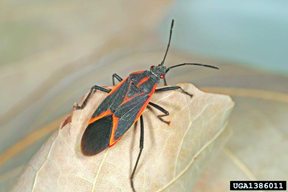
The ever present, but polite boxelder bug.
Photo by J. Berger, USA. Courtesy of Bugwood.org
Multicolored Asian lady beetle
The multicolored Asian lady beetle, Harmonia axyridis (Coleoptera: Coccinellidae) is by far the most annoying of the fall invaders. They bite, they stink and they do not keep to themselves like the more considerate boxelder bugs. They can be easily distinguished from other species of lady beetles by their larger size and presence of a black M-shaped pattern directly behind their head. Adults are large for ladybeetles and are about 1/4 inch long and 3/16 inch wide. Coloration varies (hence their common name) from bright orange with up to 19 black spots in some individuals to dull yellow with pale or no visible spots on others.
The multicolored Asian lady beetle is a native of Asia. There were several attempts to introduce the beetle into the southeastern and southwestern portions of the United States to help control aphids on pecan trees back in the late 1970’s. Some say that none of these deliberate attempts succeeded, but that the beetle became established after “jumping ship’” somewhere along the Gulf Coast. Since then it has spread rapidly throughout the United States and southern Canada. It was first found in Ontario in 1992. Despite popular rumors, the beetle was not released by the DNR, MSU, or chemical companies. One reason that might explain their large numbers is our newest aphid pest, the soybean aphid. This aphid was discovered in Michigan and other Midwestern states during the summer of 2000. Thousands of these aphids can occur on a single soybean plant and the multicolored Asian ladybeetle is known to take advantage of this unlimited food source. When soybean aphid populations are high, we have experienced high numbers of lady beetles invading homes in the fall. Thankfully, soybean aphid numbers were low this past summer, so let’s keep our fingers crossed.
During the fall, many people complain that the beetles bite, which in fact they do. These bites are very different from the bite of a mosquito and other blood sucking parasites. The bite of the multicolored Asian ladybeetle is more like a pinch and no blood meal is taken. The bite can be painful and very annoying if many of the beetles are present. If crushed or threatened, the beetles will emit a foul odor and leave a stain. People have complained that this odor lingers in their vacuum cleaners after collecting the beetles in their homes.
In kinder and gentler times when we were just dealing with our adorable native ladybeetles, I would not recommend killing them because they were cute and beneficial insects, but exotic invasive species often require desperate measures. The multicolored Asian ladybeetle is NOT a protected species (another popular rumor). Spraying the exterior to help reduce the number of these swarming insects may not be a politically or socially correct action, but treating one’s home is an option. It is difficult to imagine that the overall population of multicolored ladybeetles will be much reduced by folks spraying homes to keep them out. Those who fancy these beetles can vacuum them up and then release them some distance away from their house.
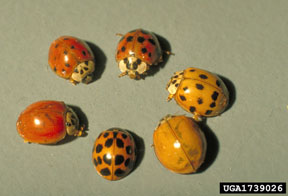
The various colors and spot patterns of the
obnoxious multicolored Asian ladybeetle.
Photo by B. Ree, Texas A&M University, Courtesy of Bugwood.org.
Cluster fly
The cluster fly, Pollenia rudis (Diptera: Calliphoridae) is another species that enters homes in late summer and early fall in search of protected sites in which to spend the winter. Cluster flies resemble the common house fly but differ in that they have a patch of yellow hairs under their wings. The cluster fly maggot is an internal parasite of earthworms and the flies are among the first to be active in the spring. They can be observed buzzing around yards just above the ground. They lay their eggs in cracks in the soil and the eggs hatch in about three days. Newly hatched maggots grab onto earthworms as they slither by and burrow into the worm to feed. Four to five weeks are required to complete a life cycle. The worm does not usually survive the experience. There are up to four generations of cluster flies in Michigan each year. Treating yards with insecticides to kill earthworms has not been shown to be effective in reducing the number of flies entering homes.
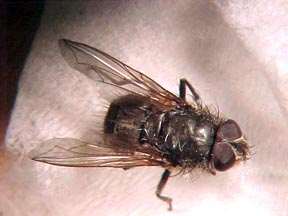
From above, the cluster fly looks pretty
much like a garden variety house fly.
Photo by H. Russell, MSU Diagnostic Services.
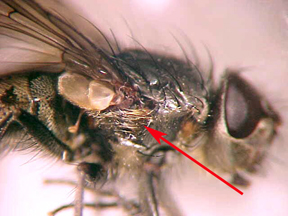
When a cluster fly is viewed from the side,
a patch of golden hairs under the wings is
easily seen. Photo by H. Russell, MSU Diagnostic Services
Western conifer seed bug
The western conifer seed bug, Leptoglossus occidentalis (Hemiptera: Coreidae) is the largest of the fall invading insects and is more of a problem for people who have several pine trees in their yards. This bug is thought to be a western species that more or less expanded its range to now include most of the United States. This true bug feeds mainly on the seeds and developing cones of several species of conifers. The western conifer seed bug is 3/4 inch long and brownish on top. The upper (dorsal) side of the abdomen is yellow or light orange with five transverse black patches. This bug produces a single generation each year.
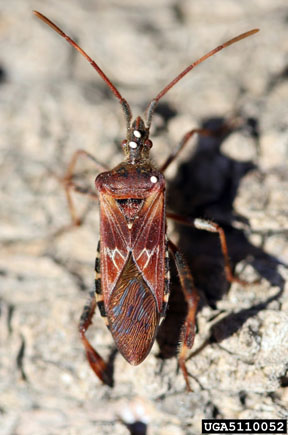
Foreign grain beetle
The foreign grain beetle, Ahasverus advena (Coleoptera: Cucujidae) feeds primarily on molds and fungi growing on damp grain, grain products, and other materials. It is found throughout the world and is very common around grain processing facilities where damp, moldy grain is allowed to accumulate. Little is known about its habits in "nature," however, it is reasonable to assume this beetle can occur in any damp situation where fungi persist. When found around the home, the beetle may come from damp crawlspaces, basements, bark mulch, and possibly moldy flour or flour products. It is also very likely that the beetles originate outside and are attracted to something inside that is damp and moldy. These beetles can fly and are very small, so it is possible for them find their way into the house through screens and around loosely fitting windows and doors. One odd thing about this beetle is that many, if not most, of the specimens sent to the lab were collected from new homes. Possibly, because the wood, plaster, concrete and other building materials in new construction may not be completely dry and support a thin, invisible layer of fungi which attracts the beetles. These insects will stop coming in from the outside as colder fall temperatures arrive.



 Print
Print Email
Email